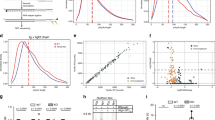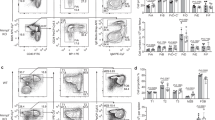Abstract
The mouse immunoglobulin μ gene encodes both secreted and surface-bound μ heavy chains produced by cells of the B lymphoid series. Transcripts of the μ gene are processed into μ mRNA species which differ at their 3′ termini, bearing either ‘μS’ or ‘μM’ segments, distinguishing secreted and cell-membrane-bound μ polypeptides1–3. During maturation of surface IgM-bearing B cells to IgM-secreting plasma cells, both the total amount of μ mRNA and the ratio of μS to μM-terminated mRNA increase greatly1,3,4. Two possible mechanisms for the developmental regulation of 3′ RNA processing cannot yet be distinguished. One mechanism would yield the μS terminus by specific cleavage of a common presursor transcript encompassing both μS and the μM exons (Fig. 1), the other by regulated termination of transcription upstream from the μM exons2,5. While the first mechanism would produce, as a by-product, RNA fragments containing μM exons, the second would not. We report here the detection of such μM fragments in cells producing predominantly μS-terminated RNA species.
This is a preview of subscription content, access via your institution
Access options
Subscribe to this journal
Receive 51 print issues and online access
$199.00 per year
only $3.90 per issue
Buy this article
- Purchase on Springer Link
- Instant access to full article PDF
Prices may be subject to local taxes which are calculated during checkout
Similar content being viewed by others
References
Rogers, J. et al. Cell 20, 303–312 (1980).
Early, P. et al. Cell 20, 313–319 (1980).
Alt, F. W. et al. Cell 20, 293–301 (1980).
Perry, R. P., Kelley, D. E., Coleclough, C. & Kearney, J. F. Proc. natn. Acad. Sci. U.S.A. 78, 247–251 (1981).
Rogers, J. et al. Cell 26, 19–27 (1981).
Kemp, D. J., Harris, A. W., Cory, S. & Adams, J. M. Proc. natn. Acad. Sci. U.S.A. 77, 2876–2880 (1980).
Kemp, D. J., Harris, A. W. & Adams, J. M. Proc. natn. Acad. Sci. U.S.A. 77, 7400–7404 (1980).
Cory, S., Adams, J. M. & Kemp, D. J. Proc. natn. Acad. Sci. U.S.A. 76, 4627–4631 (1980).
Alt, F. W., Rosenberg, N., Enea, V., Siden, E. & Baltimore, D. Molec. cell. Biol. 2, 386–400 (1982).
Zuniga, M.-C. D., Eustachio, P. & Ruddle, N. H. Proc. natn. Acad. Sci. U.S.A. 79, 3015–3019 (1982).
Raschke, W. C., Mather, E. L. & Koshland, M. E. Proc. natn. Acad. Sci. U.S.A. 76, 3469–3472 (1979).
Köhler, G., Howe, S. C. & Milstein, C. Eur. J. Immun. 6, 292–295 (1976).
Cory, S. & Adams, J. M. Cell 19, 37–51 (1980).
Alwine, J. C., Kemp, D. J. & Stark, G. R. Proc. natn. Acad. Sci. U.S.A. 74, 5350–5354 (1977).
Berk, A. J. & Sharp, P. A. Proc. natn. Acad. Sci. U.S.A. 75, 1274–1278 (1978).
Sharp, P. A. Cell 23, 643–646 (1981).
Dunnick, W., Rabbitts, T. H. & Milstein, C. Nature 286, 669–675 (1980).
Seidman, J. G. & Leder, P. Nature 286, 779–783 (1980).
Bothwell, A. L. M. et al. Nature 290, 65–67 (1981).
Rogers, J. & Wall, R. Proc. natn. Acad. Sci. U.S.A. 78, 7497–7501 (1981).
Baker, R. M. et al. Cell 1, 9–21 (1974).
Galfré, G., Howe, S. C., Milstein, C., Butcher, G. W. & Howard, J. C. Nature 266, 550–552 (1977).
Littlefield, J. W. Science 145, 709–710 (1964).
Bailey, J. M. & Davidson, N. Analyt. Biochem. 70, 75–85 (1976).
Adams, J. M., Gough, N. M., Webb, E. A., Jackson, J. & Cory, S. Biochemistry 19, 2711–2719 (1980).
Gough, N. M., Kemp, D. J., Tyler, B. M., Adams, J. M. & Cory, S. Proc. natn. Acad. Sci. U.S.A. 77, 554–558 (1980).
Mohit, B. & Fan, K. Science 171, 75–77 (1971).
Warner, N. L., Daley, M. J., Richey, J. & Spellman, C. Immun. Rev. 48, 197–243 (1979).
O'Farrell, P. H., Kuttner, E. & Nakanishi, M. Molec. gen. Genet. 179, 421–435 (1980).
Bolivar, F. et al. Gene 2, 95–113 (1977).
Author information
Authors and Affiliations
Rights and permissions
About this article
Cite this article
Kemp, D., Morahan, G., Cowman, A. et al. Production of RNA for secreted immunoglobulin μ chains does not require transcriptional termination 5′ to the μM exons. Nature 301, 84–86 (1983). https://doi.org/10.1038/301084a0
Received:
Accepted:
Issue Date:
DOI: https://doi.org/10.1038/301084a0
This article is cited by
Comments
By submitting a comment you agree to abide by our Terms and Community Guidelines. If you find something abusive or that does not comply with our terms or guidelines please flag it as inappropriate.



